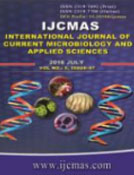


 National Academy of Agricultural Sciences (NAAS)
National Academy of Agricultural Sciences (NAAS)

|
PRINT ISSN : 2319-7692
Online ISSN : 2319-7706 Issues : 12 per year Publisher : Excellent Publishers Email : editorijcmas@gmail.com / submit@ijcmas.com Editor-in-chief: Dr.M.Prakash Index Copernicus ICV 2018: 95.39 NAAS RATING 2020: 5.38 |
Dalbergia melanoxylon is an economically important tropical tree not only for high-quality wood but also as a medicinal plant. Antimicrobial activity of crude petroleum ether, chloroform, methanol and aqueous extracts of the stem bark, root and leaf of D. melanoxylon were investigated. Solvent extractions were done through serial extraction with increasing order polarity of solvents. Different concentration ranging from 50 mg/ml to 250 mg/ml of crude extracts of plant plants were used to antimicrobial activity of D. melanoxylon. Microbes used for antimicrobial tests were Staphylococcus aureus (ATCC25923), Eschericia coli (DSM1103) and Candida albicanas (ATCC9002). The results have revealed that at high concentration of crude extracts the antimicrobial activity was significant high compared to low concentration. Stem extracts had the highest zone of inhibition 19.38 ± 1.53 mm at 250 mg/ml concentration for S. aureus (ATCC25923) followed by leaf extract for C. albicans (ATCC 9002) which had zone of inhibition of 18.67 ± 0.88. Methanol and aqueous extracts had better scores for antimicrobial activity compared to other solvents. Phytochemical screening revealed the presence of different phytochemical constituents in different plant parts thus unveiling the antimicrobial potential of D. melanoxylon. The ability of the crude extracts of D. melanoxylon to inhibit the growth of bacteria and fungi is an indication of its potential for broad application as antimicrobial agent.
 |
 |
 |
 |
 |